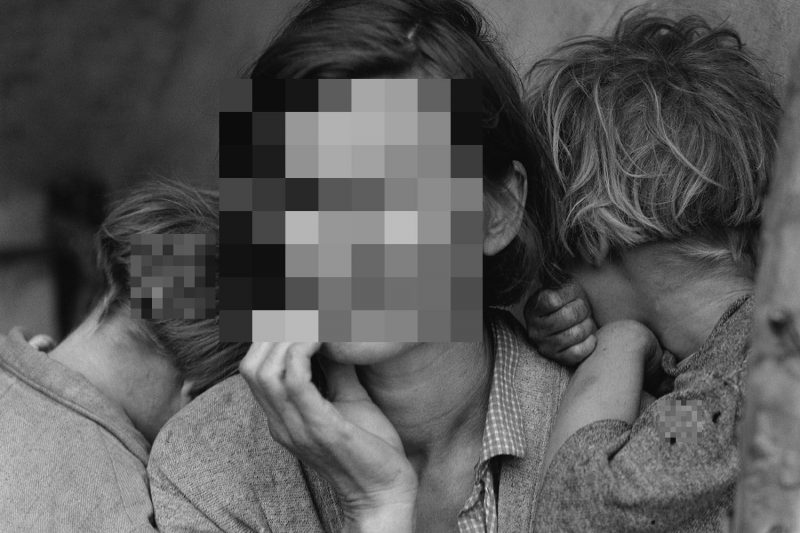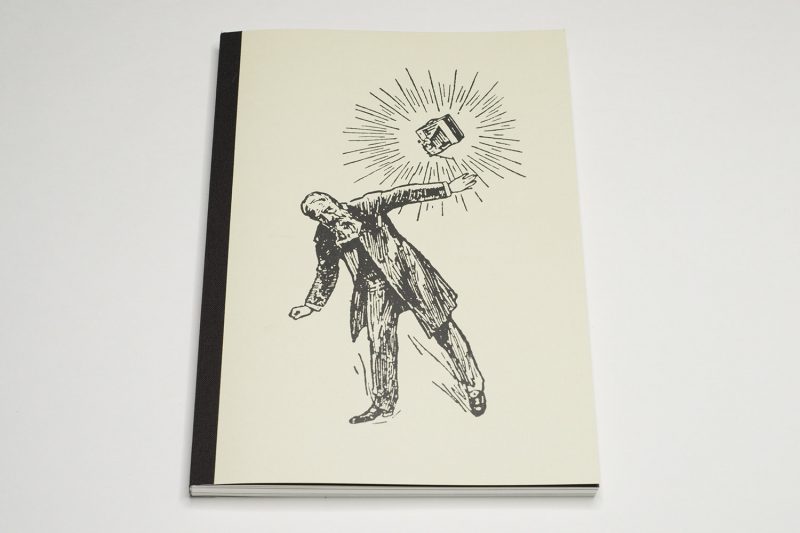One of photography’s most important problems is the power imbalance between someone operating a camera and someone finding her or himself in front of it. Unless there is an actual collaboration going on, it is the photographer whose decisions result in what the subject looks like in the picture(s). I used “actual” in front of “collaboration” on purpose: unlike many other people, I do not think that having some chit chat with a subject makes for a collaboration. A collaboration would be a joint making of the picture, in which photographer and subject talk about how the subject wants to be portrayed, what the photographer sees in her or him, etc.
Obviously, you can take amazing photographs of someone without collaborating with your subject. But you will have to realize and fully own your own role in shaping such photographs. We often do not talk about this aspect of photography, instead focusing only on the (aesthetic) quality of the work in question. And why would we? Especially when we’re dealing with photography that aspires to be art, its maker and her or his vision is what we need to focus on.
And yet…
I often wish that we didn’t conflate someone’s depiction of another person with that other person. In particular, I often wish we would pause for a moment and imagine if we were content with being portrayed this way, were we to find ourselves in front of the camera in question.
In many cases, such discussions fall by the wayside because the photographer obtained consent to do her or his job: can I take a picture of you? Asking this question presents the intended subject with the option to agree or to say no.
Of late, self-awareness appears to have increased, and for sure there also are cultural/societal aspects that play into people’s willingness or unwillingness to be photographed. We are not only surrounded by a lot of photographs, which I can’t help but feel must increase our awareness of their power, we can also take the photographs of ourselves with our smartphones (let’s ignore the debate whether selfies and self portraits are the same thing or not — for me, they are).
In other words, we have a choice: we can have all the power over how we are portrayed, or we can give someone else that power if we are being asked.
Beyond the selfie, this choice sits at the center of many debates around photography, diversity, and representation today. Historically speaking, the white middle and upper classes in the West have always enjoyed the privilege of being able to mostly determine how they were portrayed, with straight white men getting granted most of the privileges. In contrast, poor or working-class white people haven’t been so lucky, and everybody else — people of colour — have mostly been at the receiving end of what a camera can do.
If everybody is given the same rights, this does not only entail erasing political and economical differences. It also means giving everybody the same power concerning the question how they are being portrayed and by whom. Representation matters.
The question of consent has become one of the aspects of photography that I feel we should be discussing: is it a photographer’s duty to obtain consent from their intended subject(s)? In light of what I wrote about street photography years ago, it might not surprise anyone to read that I think it is a photographer’s duty to obtain consent even if the law will provide cover when there’s a lack of consent. For me, an unwillingness to obtain consent is an abuse of the power dynamic that’s inherent in photography.
But it doesn’t necessarily end with consent. That’s only part of the problem at hand. There’s a different way to approach the topic that is a bit less photography centric. Instead of focusing only on consent, we could ask the following two questions. Who is allowed to or should tell whose stories? What obligations come with telling someone else’s story?
I believe that anyone can tell any other person’s story. But I also believe that they can only do so if they are not only fully aware of their obligations but also take good care to avoid any of the many, many problems we know from the history of photography. This approach leaves a lot of leeway for the making of pictures. But those groups that traditionally enjoyed the most rights (straight white men) are now faced with the largest set of obligations.
As it turns out, this topic cuts across many areas of seemingly unrelated photography. In itself, photoland is highly fragmented, with many of the separate parts hardly speaking with each other (or even using the same language). The “fine art” area usually is the one where previously unrelated material might be discussed anew, as, for example, fashion photographers or photojournalists show their work not in print publications (online or off) that often reach very large numbers of people but on the walls of commercial galleries or museums.
This disconnect between different sections of photoland is unfortunate, since often, the same debates are being held in parallel (possibly using different terms), or the same problems, challenges, or crises arise.
Thinking about consent, there isn’t such a huge difference between, let’s say, the world of street photography and the world of news photography. Ethical and legal issues apply equally; the only difference are the possible consequences someone might be facing if a photograph was taken without their permission (check this out: “Five news outlets, including The Seattle Times, will have to comply with a subpoena and give the Seattle Police Department unpublished video and photos from a May 30 racial justice protest that turned violent, a judge ruled Thursday.”).
I’d even argue that the overall attitude of the photographers is very similar. Street photographers justify their not obtaining consent with the idea that they’re producing art, and news photographers very similarly argue that they’re providing the news which does not allow for any modification. Whatever the details of these two examples actually are, the overarching idea is the same: it is the photographer (and the organizations behind her or him) that decide over the taking and use of other people’s pictures.
It seems obvious that photography professionals do have a deeper understanding of how photographs operate and what they might mean. However, as far as I’m concerned this fact should not be used as a cover to dismiss the concerns by those who are being photographed.
One of the reasons why I re-focused things away from consent to explicitly asking about obligations is rooted in photography’s past. For example, Dorothea Lange got permission from Florence Owens Thompson to photograph her and her children. But Thompson, who was turned into the iconic “migrant mother” ended up being deeply resentful over how things unfolded: “I’m tired of symbolizing human poverty when my living conditions have improved.” You can find all the details in this article (from which the quote is taken).
In much the same fashion, the subjects of Walker Evans’ famed work in Alabama were not happy with how they had been treated photographically. Here’s Phil Burroughs, grandson of Floyd, describing how his father felt about things: Angry, “to be honest with you, I think he had a right to be. I honestly do. You were looking at people that were struggling to put food on the table, you know? It was a simple life. They didn’t have anything. Everybody wants something. That’s probably the American dream. Everybody wants something. So it kind of left a bad taste in everybody’s mouth. Maybe that’s hard for a lot of people to understand, but it absolutely did. It made him upset, it really did. They were cast in a light that they couldn’t do any better, that they were doomed, ignorant. How would you feel if somebody cast your folks, your parents, or your grandparents in that light? Even though I know they were real poor, no doubt about that, but they weren’t ignorant, and they definitely weren’t lazy.” (source)
And let’s not even get started with colonial photography or its contemporary equivalent when Western photojournalists are dispatched to photograph “conflict” (or whatever else) in non-Western countries.
There are many more examples of photographers’ subjects becoming deeply resentful over how they were being portrayed. Your mileage might vary, but I firmly believe that it’s photographers’ responsibility to listen to what people have to say.
For example, when there was an outcry over Annie Leibovitz’s pictures of Simone Biles, you have to make an attempt to understand where that’s coming from and what that means (even if you’re not in the business of making such pictures for magazine covers). I immediately thought of Lorna Roth’s article Looking at Shirley, the Ultimate Norm: Colour Balance, Image Technologies, and Cognitive Equity: There is a part of the history of photography that literally encoded non-white skin looking terrible in photographs.
Coming back to the questions I posed — Who is allowed to or should tell whose stories? What obligations come with telling someone else’s story? — I don’t think there’s a one-size-fits-all solution, in particular concerning the first question. Circumstances will have to be considered carefully.
I actually think that the main focus should be on the second question: what are your obligations if you tell someone else’s story? These obligations include a variety of different aspects — obligations created by the field you operate in, obligations given your audience, but and especially also obligations towards those who are in your pictures. So far, I’m finding that this latter aspect is all-too-often sorely neglected.
As a photographer, you will have to look outside of your own photoland-bubble. It’s so convenient to convince yourself that what you’re doing is the right thing, given you’ve discussed this with all of those peers (who somehow all think alike and none of whom typically have a foot outside of the bubble). That’s the problem: the groupthink. Jay Rosen, journalism professor at NYU, relies on this term a lot when talking about problems in journalism.
Another term used by Rosen frequently is “the view from nowhere” — the idea that journalists somehow occupy a neutral position, and it’s their duty to report faithfully what’s being said, regardless of how insane one side might turn out to be (you can probably guess how that’s a problem in the Age of Trump).
Most photographers aren’t journalists, but I see variations of this idea applied a lot in photoland. There, it mostly comes down to photographers thinking of themselves as elevated, distinct observers who somehow can distill something about the world in ways that nobody else can. In some basic ways, this is true (it’s true for any profession — I couldn’t do what my dentist does). But the conversation can’t stop there.
In fact, that’s where it should begin: OK, given that this photographer has just made this observation about that person — what follows from that? What does that do? What does it lead to? What does it tell us about that person? And could we imagine that that person might agree or disagree with how s/he is being portrayed?
Consent is the necessary starting point. And then, we need to talk about not just the pictures, but all of their consequences — those inside of photoland and those outside.
I’ve set up a tip jar. If you’ve enjoyed this article (or site), feel free to leave a tip to support my work. Thank you!
Also, there is a Mailing List. You can sign up here. If you follow the link, you can also see the growing archive. Emails arrive roughly every two weeks or so.















